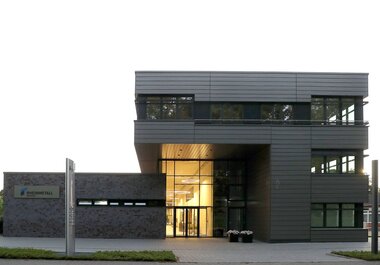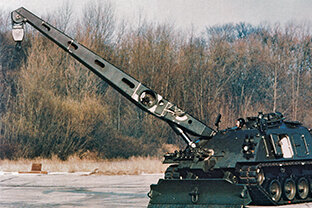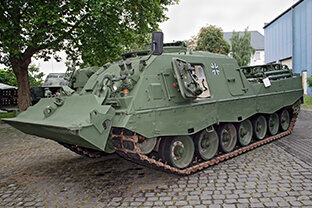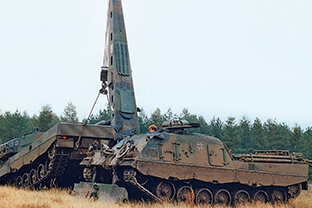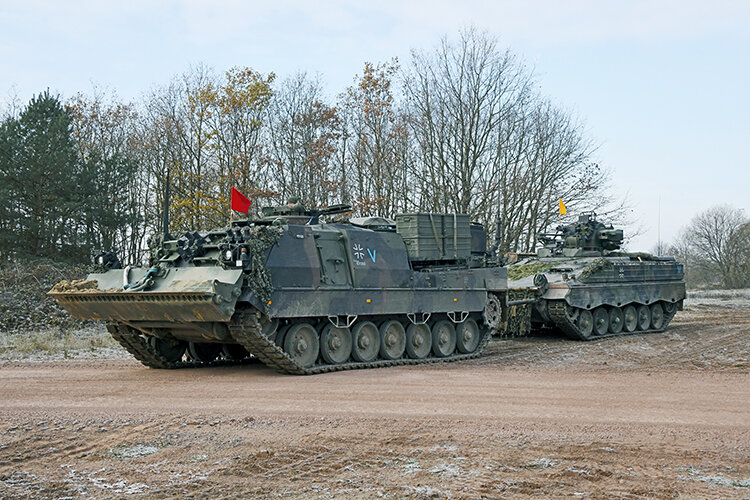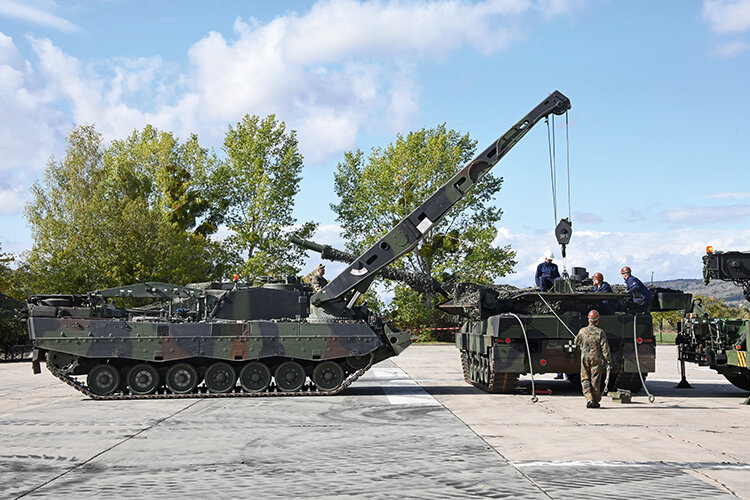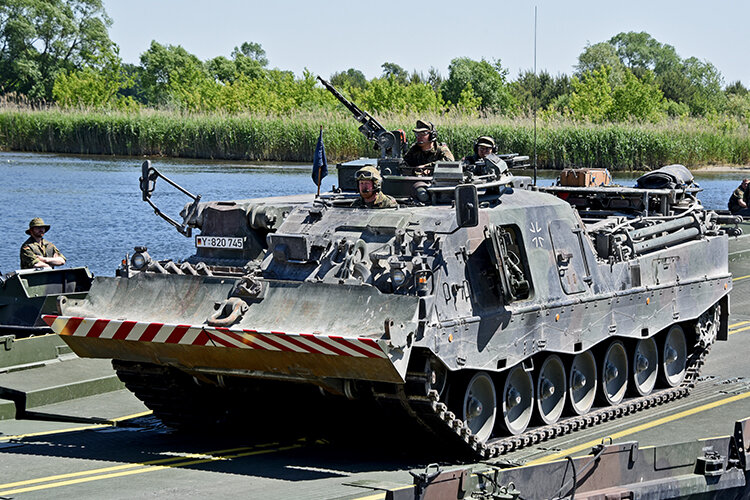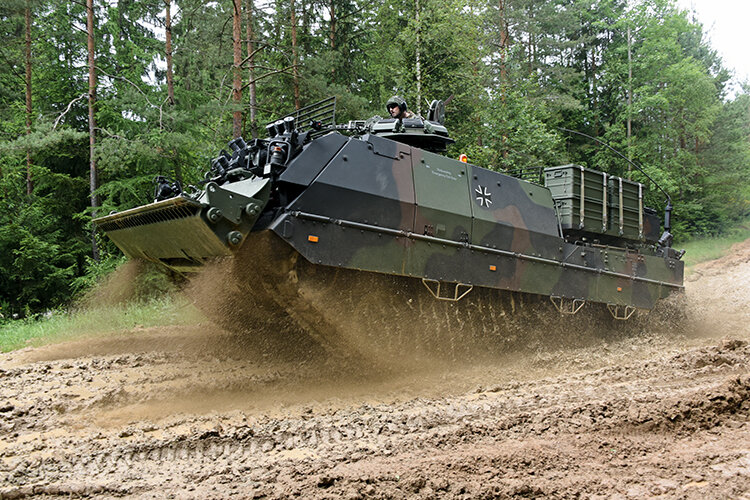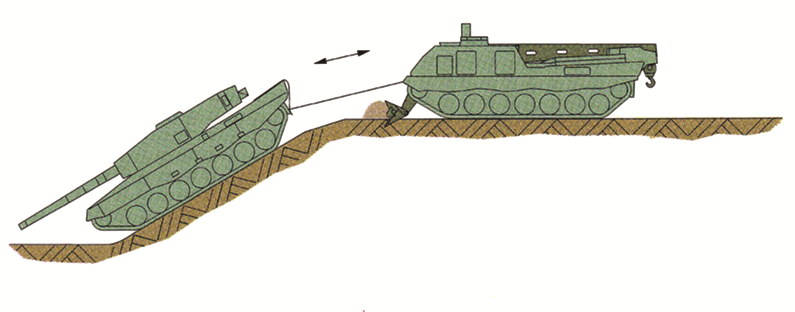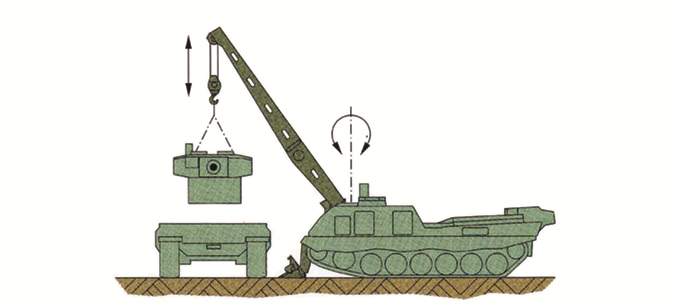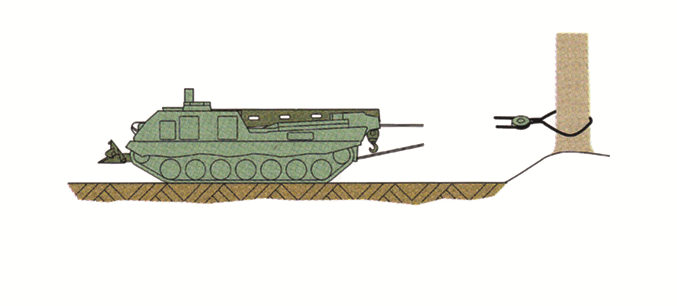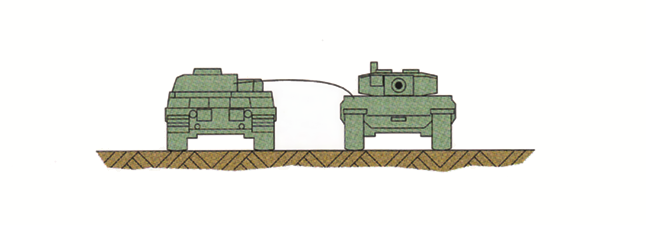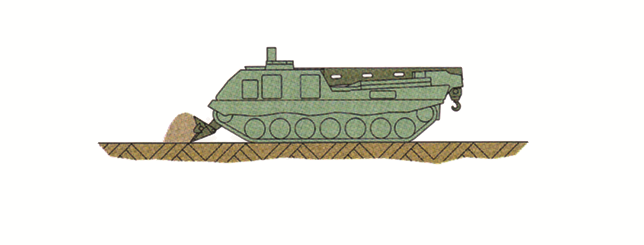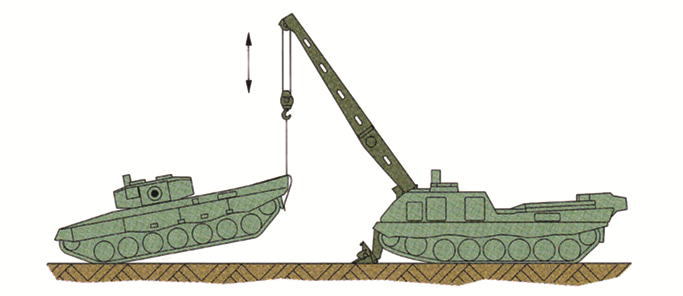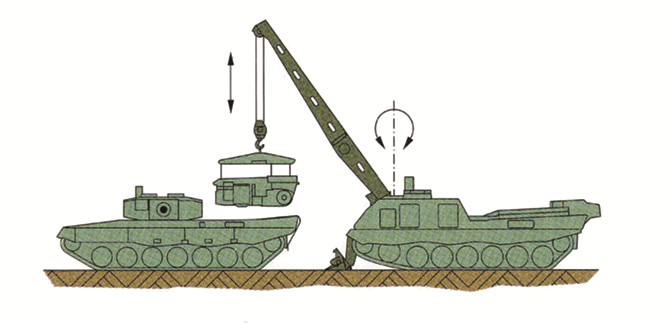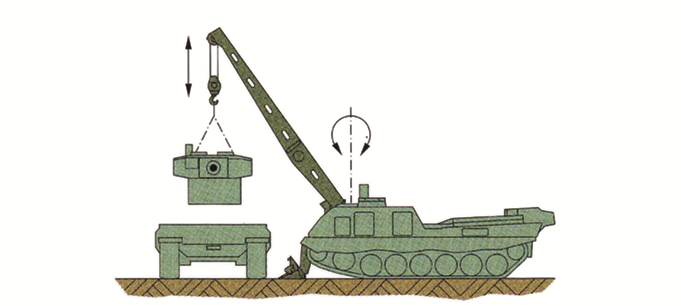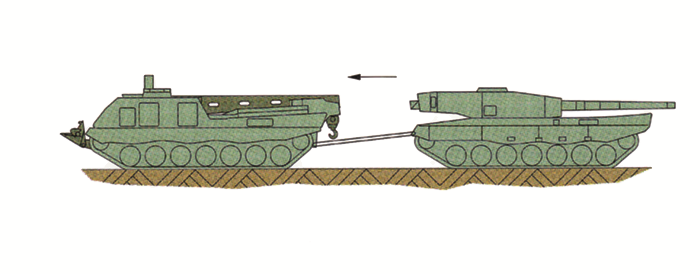
23/11/2022 | Story
30 years Bergepanzer 3 Büffel – Support for the armed forces
The development of the prototypes
From Maschinenbau Kiel AG to Rheinmetall Landsysteme GmbH
Maschinenbau Kiel AG was founded in 1948. Originally dating back to a Royal Prussian artillery depot in Friedrichsort near Kiel in 1866, its activities were in the locomotive and engine construction industry.
The Stinnes and Flick groups – together MaK – took over in 1954. In 1958, it joined a consortium for the development of the Leopard 1 main battle tank. MaK, which was converted into a GmbH (German limited liability company), was acquired by Krupp in 1964. The fi rst Bergepanzer 2 armoured recovery vehicle, developed jointly with Porsche and Jung, was handed over to the Bundeswehr in 1966. Final assembly of the fi rst Marder infantry fi ghting vehicles began in 1970, followed by the assembly of Leopard 1 main battle tanks in 1974 and series production of the Leopard 2 in 1976. MaK has produced the Wiesel armoured transport vehicle since 1980. In 1981 the development of the German-Dutch joint project Bergepanzer 3 armoured recovery vehicle began, in 1983 the Keiler mine-clearing tank, and in 1990 the Panzerhaubitze 2000 howitzer. In 1990, Rheinmetall acquired the defence technology section of MaK, the specially spun-off MaK System Gesellschaft, and merged it with KUKA and Henschel to form Rheinmetall Landsysteme GmbH in 2000. Major projects since 1990 have included the GTK Boxer and the Puma infantry fi ghting vehicle, which was developed, produced and marketed jointly with Kraus-Maffei Wegmann.
System description
The Bergepanzer 3 Büffel armoured recovery vehicle is based on the Leopard 2’s familiar chassis and has a winch system, a crane boom that can be swivelled through 270° and a support and clearing blade. The hydraulically operated jib crane on the right side of the hull, and its lifting winch is directly integrated into the crane boom. It has a maximum hook load of 30 tonnes with a crane outreach of 90 centimetres from the front edge of the support and clearing blade. The Rotzler Treibmatic TR 650/3 main winch is located in the operating compartment under the intermediate floor. It has a maximum pulling force of 35 tonnes. Loads of 70 to 105 tonnes can be moved in the double and triple pull. The left hull front housed the auxiliary winch, a HZ 010 Rotzler drum winch with a pulling force of 7 to 8.3kN when the first Bergepanzer 3 Büffel armoured recovery vehicles were delivered. A more powerful version of this winch is used in current Bergepanzer 3 armoured recovery vehicles.
The support and clearing blade at the front of the vehicle, in conjunction with a rapid recovery device (only on the Bergepanzer 3 Büffel armoured recovery vehicle), allows the recovery of damaged vehicles under armoured protection.
The Bergepanzer 3 Büffel armoured recovery vehicle owes its outstanding mobility to the tried-and-tested torsion bar-suspended support roller drive known from the Leopard 2 main battle tank with slat dampers as well as hydraulic end stop dampers and fixed end stops above the swinging arms of the roller pairs. In order to prevent the running gear from deflecting during crane work, it can be blocked hydraulically. The drive is provided by the drive block, consisting of a motor and gearbox, in conjunction with the two side countershafts and the sprockets on the two end connector tracks. As with the Leopard 1-based armoured recovery vehicle, the Bergepanzer 3 Büffel armoured recovery vehicle’s engine is designed as a complete engine block. Installation and removal is therefore possible within a few minutes even under military conditions, as there are only a few supply lines between the vehicle and the engine block, which are to be disconnected or connected by means of quick-disconnect couplings and plugs. The liquid-cooled 47.6-litre MTU MB 873 Ka 501 12-cylinder pre-chamber multi-fuel diesel engine with twin exhaust turbochargers and charge air cooling produces 1,100kW (1,500hp) at a drive speed of 2,600rpm. The semiautomatic and fully automatic shiftable hydromechanical Renk HSWL 354 shift, reversing and steering gear with combined hydrodynamic-mechanical service brake is used for power transmission to the end connector track. The gearbox, flanged to the engine via quick-release clamps, consists of a torque converter with mechanical lock-up clutch, reversing gear for forward/reverse, powershift 4-speed automatic transmission, hydrostatic/hydrodynamic steering gear, retarder brake and friction brake, as well as the electronic transmission control.
The support and clearing blade is primarily used to support the armoured recovery vehicle when working with the crane system and the main winch system. It is also used as a tool for earthworks, for manoeuvring as well as for holding a vice. In addition, the stop lugs on the clearing blade of the German Bergepanzer 3 Büffel armoured recovery vehicle are used to accommodate the quick recovery device.
The Bergepanzer 3 Büffel armoured recovery vehicle’s crane system is mounted on the hull at the front right. It is used for lifting, lowering and swivelling loads of up to 30 tonnes. The crane system consists of the pivot bearing, the pivot engine, the crane console, the crane boom, the crane boom cylinder, the lifting winch, the pulley block and the load hook. The crane system is controlled by a unit that is stowed to the right of the driver’s seat. For crane operation, it can also be removed from the holder and placed on the hull next to the driver’s hatch. The load display in the control panel to the right of the driver’s seat continuously shows the maximum load resulting from the respective position of the vehicle and the crane boom as well as the actual hook load, thus giving the operator the possibility to estimate the available load reserves.
A load torque limiter permanently monitors the load torque applied by the load, ensures the stability of the BPz3 and prevents safety-critical conditions when working with the crane system.
The main winch system consists of the Rotzler Treibmatic TR 650/3 capstan winch, the swivel pulley block and the cable reel drum (storage drum). The main winch is installed in the operating area below the driver’s seat behind the swivel pulley block. Directly behind the main winch in the hull base is the large cable reel drum. The swivel pulley block aligns itself according to the respective cable pull force direction and ensures short main winch cable guidance from the bow with low friction losses. The hydraulically driven main winch generates a pressure-dependent tractive force according to the traction sheave principle. The power is transmitted to the main winch cable with a diameter of 33mm by means of a pre-tensioning force and the resulting frictional force connection. This functional principle ensures a constant tractive force and cable speed over the existing main winch rope length. The 160m long main winch cable is stored without tension in the cable reel drum, whereby the usable cable length is 140m. The main winch is controlled via the left-hand control lever on the control unit, which is located to the right of the driver’s seat. In first gear, the main winch has a pulling force of 343kN at a cable speed of 16m/min. In second gear, the tractive force is 47kN at a cable speed of 83m/min.
The auxiliary winch, a Rotzler HZ 010 drum winch, has a pulling force of 13.5 to 15.5kN. It is located in the front left hull area and is controlled via the operating lever to the left of the driver’s steering wheel. It is used to feed the main winch cable or recovery material to the anchor point. The cable speed varies between 50 and 59m/min. The auxiliary winch driven by the flange-mounted hydraulic motor consists of a cable reel drum with single-stage planetary gear, the drive shaft and the spooling device driven by sprockets and chains. The 230m long cable of the auxiliary winch has a diameter of 7.2mm.
The vehicle also has an electric cutting and welding device that works without an additional power generator. The fire suppression system with the DeuGen-N (FE36) extinguishing agent protects the crew as well as the various assemblies in the control room in the event of a fire and is designed in such a way that an automatic extinguishing process starts at the latest 50ms after a fire is detected. The preheating and heating system located in the rear left hull area is used to preheat the engine block at low temperatures and to heat the driver and operator compartment. The compact NBC protective ventilation system is located on the right-hand side of the hull behind the crane console, above the second and third pair of wheels and accessible from the outside. This ensures, the three-man crew is protected from the effects of attacks with nuclear, biological and chemical warfare agents. A manually operated 2350 weapon system is inserted into the roof of the control room. This serves to hold a 7.62 x 51mm MG3A1T machine gun, which can be fired by the vehicle commander in the interior under armoured protection. Reloading is done from the outside through the open commander’s hatch. Smoke grenades can be fired using the 76mm smoke grenade launcher of the Bergepanzer 3 Büffel armoured recovery vehicle, whereby the firing is carried out electrically.
Range of applications
The mechanised units still form the major part of the German army’s armoured forces. Their ability to survive depends not only on being armed in a way that is appropriate to the threat, but also on an extraordinarily high degree of mobility. This in turn can be negated by sections of terrain that are difficult to navigate. A tank getting stuck or bogged down can very quickly lead to a premature loss of the vehicle and thus decisively weaken the combat power of a unit or tie up too many people to recover the tank. In addition, battlerelated damage to the chassis of a tracked vehicle caused by enemy weapons, mines or improvised explosive devices (IEDs) can also lead to its premature loss.
Based on these specifications, the main tasks of the Bergepanzer 3 Büffel armoured recovery vehicle are recovering tracked vehicles up to MLC80, in difficult terrain and also from bodies of water, towing heavy tracked vehicles off-road and on roads, securing tracked vehicles when crossing bodies of water, support for maintenance work, transporting engines and refuelling and defuelling tracked vehicles.
